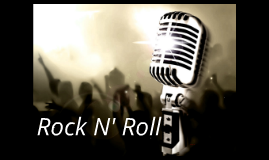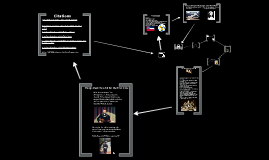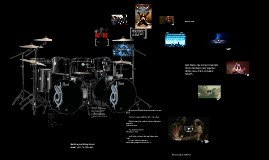Rock N' Roll
Transcript: Rock n' Roll Through the ages By Dario Jokic & Adam Anasari Rock and roll is a genre of popular music that originated and evolved in the United States during the late 1940s and early 1950s The 1940's and 1950 There is general agreement that it arose in the Southern United States - a region which would produce most of the major early rock and roll acts - through the meeting of various influences that embodied a merging of the African musical tradition with European instrumentation. The migration of many former slaves and their descendants to major urban centers like Memphis and north to New York City, Detroit, Chicago, Cleveland and Buffalo meant that black and white residents were living in close proximity in larger numbers than ever before, and as a result heard each other's music and even began to emulate each other's fashions. The immediate roots of rock and roll lay in the rhythm and blues, then called "race music", and country music of the 1940s and 1950s. Particularly significant influences were jazz, blues, gospel, country, and folk. In the 1930s jazz, and particularly swing, both in urban based dance bands and blues-influenced country swing, was among the first music to present African American sounds for a predominately white audience. The 1940s saw the increased use of blaring horns (including saxophones), shouted lyrics and boogie woogie beats in jazz based music. During and immediately after World War II, with shortages of fuel and limitations on audiences and available personnel, large jazz bands were less economical and tended to be replaced by smaller combos, using guitars, bass and drums. In the same period, particularly on the West Coast and in the Midwest, the development of jump blues, with its guitar riffs, prominent beats and shouted lyrics, prefigured many later developments. Rock and roll arrived at a time of considerable technological change, soon after the development of the electric guitar, amplifier and microphone, and the 45 rpm record.There were also changes in the record industry, with the rise of independent labels like Atlantic, Sun, Chess, and Motown Recoders servicing niche audiences and a similar rise of radio stations that played their music. The phrase "rocking and rolling" originally described the movement of a ship on the ocean, but was used by the early twentieth century, both to describe the spiritual fervor of black church rituals and as a sexual analogy. Various gospel, blues and swing recordings used the phrase before it became used more frequently - but still intermittently - in the 1940s, on recordings and in reviews of what became known as "rhythm and blues" music aimed at a black audience. Early Rock N' Roll "Rockabilly" "Rockabilly" usually (but not exclusively) refers to the type of rock and roll music which was played and recorded in the mid 1950s by white singers such as Elvis Presley, Carl Perkins and Jerry Lee Lewis, who drew mainly on the country roots of the music. Many other popular rock and roll singers of the time, such as Fats Domino and Little Richard, came out of the black rhythm and blues tradition, making the music attractive to white audiences, and are not usually classed as "rockabilly". "Doo Wop" Doo wop was one of the most popular forms of 1950s rock and roll, with an emphasis on multi-part vocal harmonies and meaningless backing lyrics (from which the genre later gained its name), which were usually supported with light instrumentation Its origins were in African American vocal groups of the 1930s and 40s, like the Ink Spots and the Mills Brothers, who had enjoyed considerable commercial success with arrangements based on close harmonies. The 1960's "The British Invasion" The British Invasion is an American term used to describe the many rock and roll, beat, rock, and pop performers from the United Kingdom who became popular in the United States from 1964 through 1966. On December 10, 1963, the CBS Evening News with Walter Cronkite ran a story about the Beatlemania phenomenon in the United Kingdom, featuring their smash hit, "She Loves You." A second wave of the invasion occurred featuring acts such as The Who and The Zombies which were influenced by the invasion's pop side and American rock music The Rolling Stones were perceived by the American public as a much more 'edgy' and even dangerous band. They stated themselves that they were much more influenced by black-oriented rhythm and blues. This image marked them as separate from beat artists such as the Beatles, who had become a more acceptable, parent-friendly pop group. Garage Rock Garage rock was a form of amateurish rock music, particularly prevalent in North America in the mid-1960s and so called because of the perception that it was rehearsed in a suburban family garage. Mid 1960-1970 Folk Music Bob Dylan had begun to reach a mainstream audience with hits including "Blowin' in the Wind" (1963) and "Masters of War" (1963), which brought "protest songs" to a wider public, but,

















